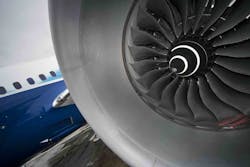Rolls-Royce Admits Delays in Turbine Replacement Effort
Rolls-Royce PLC is acknowledging to investors and airline customers that the ongoing effort replace turbine blades on some Trent 1000 engines will take longer than previously estimated, severely impeding the availability of Boeing 787 Dreamliners for some operators. Some of the engines have exhibited shorter-than expected service life due to failing turbine blades, which requires the airlines to increase the rate of inspections, a step that removes the jets from service for extended periods.
Referring to the number of idled aircraft, Rolls now indicates it will be 2Q 2020 before that total is numbered in single digits.
The Trent 1000 is a high-bypass turbofan engine developed by Rolls-Royce and introduced in 2006. It is one of two engines designs offered by Boeing for its twin-engine, wide-body commercial aircraft, it was the launch engine on both the 787-8 and 787-9 variants. Among the carriers operating Dreamliner aircraft with the Trent 1000 are ANA, Air New Zealand, British Airways, Norwegian Air, Virgin Atlantic, and several others.
The problem with the intermediate-pressure turbine (IPT) blades emerged three years ago when it was reported that ANA had discovered corrosion-related fatigue cracking on blades, which led to a round of inspections and replacement that, according to Rolls’ 2017 annual report incurred $244 million in costs for repairs and compensation.
In 2018, Rolls announced an expanded repair program for the Trent 1000 engines, following the decision by some Boeing 787 Dreamliner operators to idle the aircraft.
Also last year the European Aviation Safety Administration and the U.S. Federal Aviation Administration reduced the regular inspection interval from 200 flights to 80 flights for 380 Trent 1000 engines. EASA indicated that maintenance had identified cracks on intermediate pressure compression (IPC) rotor seals: “This condition, if not detected and corrected, could lead to in-flight blade release, possibly resulting in reduced control of the aeroplane," according to EASA at that time.
Last week Rolls reported it accelerated turbine blade replacement for some models, which prompted more aircraft to be removed from service.
Rolls is faced with about $2 billion in additional costs for the inspections.
“We deeply regret the additional disruption that this will cause our customers and we continue to work closely with them to minimize the impact on their operations,” Rolls-Royce stated.
